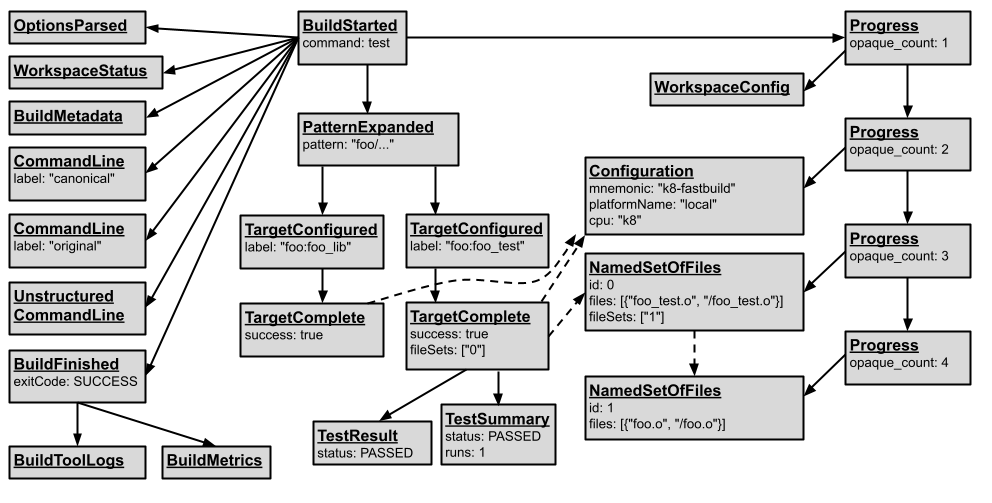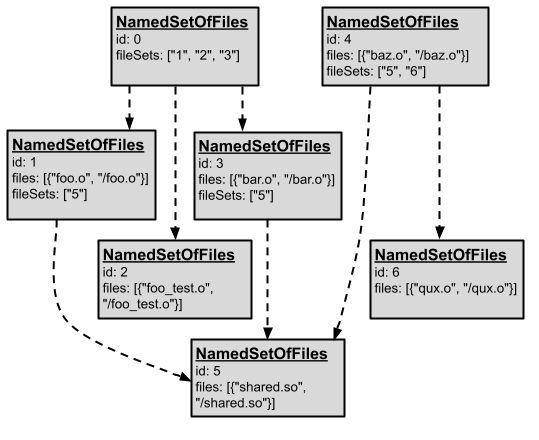如要查看建構事件通訊協定的完整規格,請參閱通訊協定緩衝區定義。不過,在查看規格之前,先建立一些直覺可能會有幫助。
假設有一個簡單的 Bazel 工作區,其中包含兩個空白的殼層指令碼 foo.sh 和 foo_test.sh,以及下列 BUILD 檔案:
sh_library(
name = "foo_lib",
srcs = ["foo.sh"],
)
sh_test(
name = "foo_test",
srcs = ["foo_test.sh"],
deps = [":foo_lib"],
)
在這個專案上執行 bazel test ... 時,產生的建構事件建構圖會與下圖類似。箭頭表示上述上層和下層關係。請注意,為簡潔起見,我們省略了部分建構事件和大多數欄位。

圖 1. 損益平衡點圖表。
一開始會發布 BuildStarted 事件。這個事件會通知我們建構作業是透過 bazel test 指令叫用,並發布子事件:
OptionsParsedWorkspaceStatusCommandLineUnstructuredCommandLineBuildMetadataBuildFinishedPatternExpandedProgress
前三個事件提供有關 Bazel 叫用方式的資訊。
PatternExpanded 建構事件可深入瞭解 ... 模式擴展至哪些特定目標://foo:foo_lib 和 //foo:foo_test。方法是將兩個 TargetConfigured 事件宣告為子項。請注意,即使 Configuration 事件是在 TargetConfigured 事件之前發布,TargetConfigured 事件仍會將 Configuration 事件宣告為子事件。
除了父項和子項關係,事件也可以使用建構事件 ID 互相參照。舉例來說,在上圖中,TargetComplete 事件是指其 fileSets 欄位中的 NamedSetOfFiles 事件。
參照檔案的建構事件通常不會在事件中嵌入檔案名稱和路徑。而是包含 NamedSetOfFiles 事件的建構事件 ID,其中會包含實際的檔案名稱和路徑。NamedSetOfFiles 事件可讓一組檔案回報一次,並由多個目標參照。否則在某些情況下,Build Event Protocol 輸出大小會隨著檔案數量呈二次方成長,因此必須採用這種結構。NamedSetOfFiles 事件也可能不會內嵌所有檔案,而是透過建構事件 ID 參照其他 NamedSetOfFiles 事件。
以下是上述圖表中 //foo:foo_lib 目標的 TargetComplete 事件例項,以通訊協定緩衝區的 JSON 表示法列印。建構事件 ID 包含目標 (不透明字串),並使用建構事件 ID 參照 Configuration 事件。這個事件不會發布任何子事件。酬載包含目標是否建構成功、輸出檔案集,以及建構的目標種類等資訊。
{
"id": {
"targetCompleted": {
"label": "//foo:foo_lib",
"configuration": {
"id": "544e39a7f0abdb3efdd29d675a48bc6a"
}
}
},
"completed": {
"success": true,
"outputGroup": [{
"name": "default",
"fileSets": [{
"id": "0"
}]
}],
"targetKind": "sh_library rule"
}
}
BEP 中的 Aspect 結果
一般建構作業會評估與 (target, configuration) 配對相關聯的動作。啟用層面後,Bazel 會針對受特定啟用層面影響的每個目標,額外評估與 (target, configuration,
aspect) 三元組相關聯的目標。
即使沒有特定層面的事件類型,您仍可在 BEP 中查看層面的評估結果。對於每個適用層面的 (target, configuration) 配對,Bazel 會發布額外的 TargetConfigured 和 TargetComplete 事件,其中包含將層面套用至目標的結果。舉例來說,如果 //:foo_lib 是以 --aspects=aspects/myaspect.bzl%custom_aspect 建構而成,這個事件也會顯示在 BEP 中:
{
"id": {
"targetCompleted": {
"label": "//foo:foo_lib",
"configuration": {
"id": "544e39a7f0abdb3efdd29d675a48bc6a"
},
"aspect": "aspects/myaspect.bzl%custom_aspect"
}
},
"completed": {
"success": true,
"outputGroup": [{
"name": "default",
"fileSets": [{
"id": "1"
}]
}]
}
}
使用 NamedSetOfFiles
判斷特定目標 (或層面) 產生的構件是常見的 BEP 用途,只要稍做準備,就能有效完成這項工作。本節將討論 NamedSetOfFiles 事件提供的遞迴共用結構,該結構與 Starlark Depset 的結構相符。
處理 NamedSetOfFiles 事件時,消費者必須小心避免使用二次方演算法,因為大型建構作業可能包含數萬個這類事件,在具有二次方複雜度的遍歷中,需要數億次作業。

圖 2. NamedSetOfFiles BEP 圖表。
NamedSetOfFiles 事件一律會出現在 BEP 串流中,早於參照該事件的 TargetComplete 或 NamedSetOfFiles 事件。這是「父項-子項」事件關係的相反情況,除了第一個事件外,所有事件都會在至少一個事件發布後顯示。NamedSetOfFiles 事件是由沒有語意的 Progress 事件發布。
由於有這些排序和分享限制,一般消費者必須緩衝處理所有 NamedSetOfFiles 事件,直到 BEP 串流耗盡為止。下列 JSON 事件串流和 Python 程式碼示範如何從「default」輸出群組中的目標/構面填入對應的建構構件,以及如何處理部分建構目標/構面的輸出內容:
named_sets = {} # type: dict[str, NamedSetOfFiles]
outputs = {} # type: dict[str, dict[str, set[str]]]
for event in stream:
kind = event.id.WhichOneof("id")
if kind == "named_set":
named_sets[event.id.named_set.id] = event.named_set_of_files
elif kind == "target_completed":
tc = event.id.target_completed
target_id = (tc.label, tc.configuration.id, tc.aspect)
outputs[target_id] = {}
for group in event.completed.output_group:
outputs[target_id][group.name] = {fs.id for fs in group.file_sets}
for result_id in relevant_subset(outputs.keys()):
visit = outputs[result_id].get("default", [])
seen_sets = set(visit)
while visit:
set_name = visit.pop()
s = named_sets[set_name]
for f in s.files:
process_file(result_id, f)
for fs in s.file_sets:
if fs.id not in seen_sets:
visit.add(fs.id)
seen_sets.add(fs.id)

